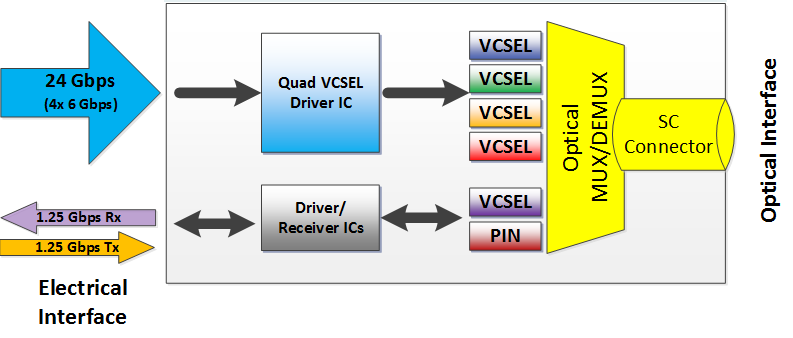What Is WDM? Why Use It?
Wavelength Division Multiplexing (WDM) is a technique that transmits multiple independent data channels over a single optical fiber, using different wavelengths (or colors) of light for each channel. This dramatically increases bandwidth capacity without increasing the number of fibers or connectors.
WDM works on a simple but powerful principle — light signals at different wavelengths can travel down the same fiber without interfering with each other, even if they’re moving in opposite directions. Unlike electrons in copper, which can clash and create noise, photons just pass right by. This means you can send more data, more ways, all at once — unlocking possibilities that simply aren’t achievable with traditional electrical connections or single-wavelength fiber links.
CWDM: Optimized for Short-Reach, High-Reliability Links
Inneos’ Coarse WDM (CWDM) approach uses wider wavelength spacing (typically 20 nm or more) to:
- Reduce cost and complexity
- Simplify alignment and thermal management
- Enable robust optical links for embedded and rugged applications
Short-wavelength WDM (SWDM) is a variation of CWDM designed specifically for short-reach multimode fiber links, just with a defined set of wavelengths: 850nm, 880nm, 910nm, and 940nm.
Unlike telecom-style Dense WDM (DWDM), which packs wavelengths very tightly together for long-haul transmission over hundreds of kilometers, Inneos’ CWDM solutions are built for a different job. Our focus is on embedded, short-reach links under 100 meters — the kind you find inside advanced systems where space is tight and integration needs to be seamless. By spacing wavelengths farther apart, CWDM optics are simpler to design, easier to align, and more tolerant of temperature changes, all while delivering the performance needed for mission-critical applications.
Technical Overview of Inneos WDM Optical Subsystems
Inneos’ WDM optical subsystems include:
- Multiple VCSEL transmitters, each operating at a unique wavelength spaced 20-30nm or more apart
- Matched photodetectors and filters for each channel on the receive side
- Integrated optical multiplexer (MUX) / demultiplexer (DEMUX) for combining and separating wavelengths
- Internal control electronics, including VCSEL driver and receiver chipsets, I²C interfaces, diagnostics, and pre-programmed temperature compensation
- Optimized fiber launch coupling into a 50µm multimode fiber with minimal insertion loss and stable coupling
- Bi-directional data allowing for simultaneous bi-di data on lower-speed channels

Block Diagram of an SH51-02C Transmitter Optical Subsystem
Key Benefits for System Designers
- Single-fiber simplicity – Replace four fiber pairs with one ruggedized multimode link.
- Protocol-agnostic performance – Can support HDMI, DisplayPort, Ethernet, MIPI, PCIe, and custom digital interfaces.
- Low latency, low jitter, no compression – Designed for real-time applications — ideal for medical imaging, aerospace controls, and industrial sensing.
- High reliability – Proven performance in mission-critical, EMI-sensitive environments.
- Modular and embeddable – Available as turnkey HDMI modules or embedded engines for OEM system integration.
Tested and Trusted in Demanding Environments
Inneos WDM optical subsystems are deployed in:
- Medical video systems for Real-time 4K/8K HDMI in ORs and imaging suites
- Military platforms for SWaP-constrained video and sensor links
- Industrial vision systems for High frame-rate cameras
- ProAV video distribution systems for Uncompressed 4K HDMI, KVM extension

How to Get Started
At Inneos, we make WDM practical — not theoretical — by solving the optical, mechanical, and electrical design challenges so you don’t have to. It’s easy to get started:
- Evaluate using one of our turnkey optical extenders or optical subsystem evaluation kits
- Prototype with our embeddable WDM optical engines
- Design-in with full support from our applications engineering team
More Bandwidth. Less Complexity. One Fiber.
Inneos WDM subsystems let you multiply bandwidth without multiplying complexity. With one fiber, you can move up to six independent channels at full speed, free of EMI, noise, or crosstalk — in a compact, rugged form factor ready for your system.
We’ve engineered the hard part. You get plug-and-perform simplicity.